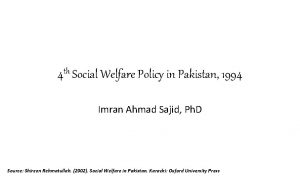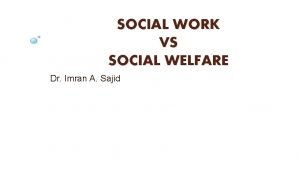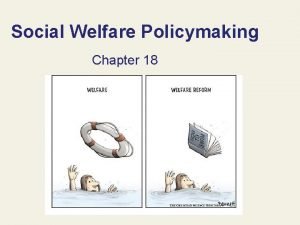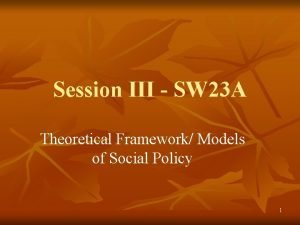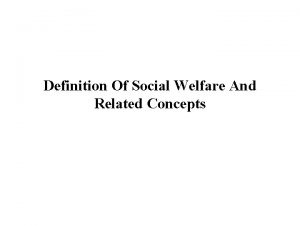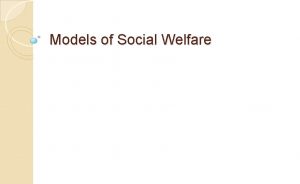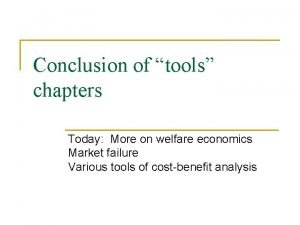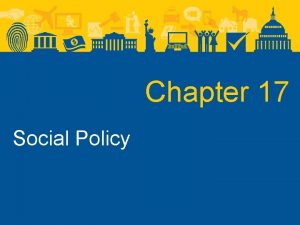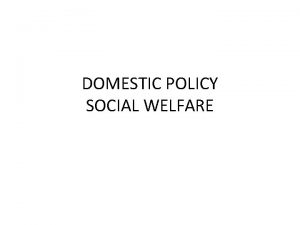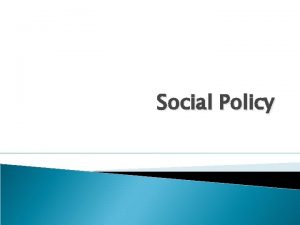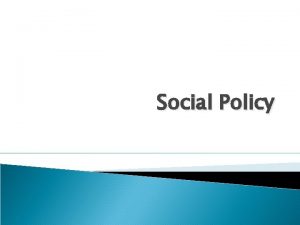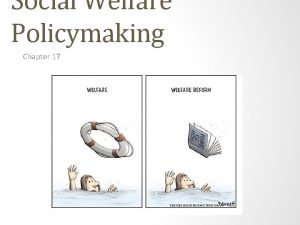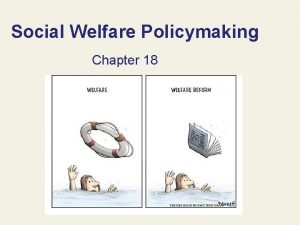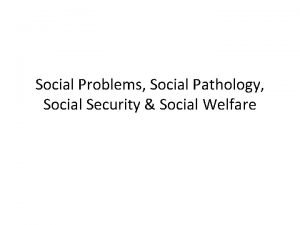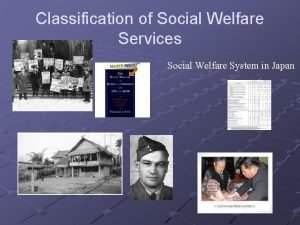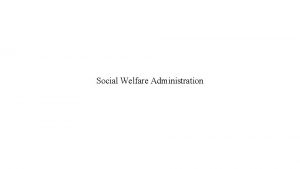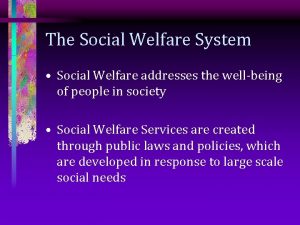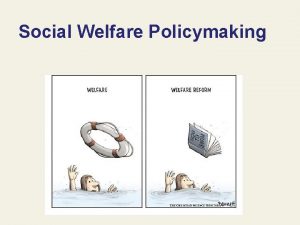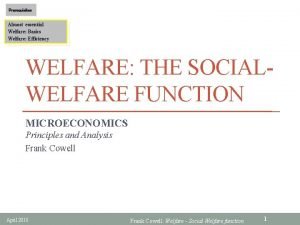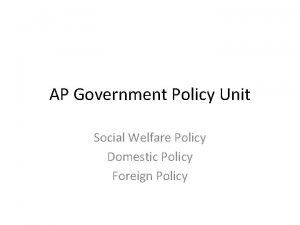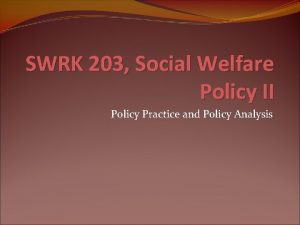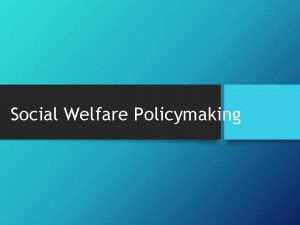Social Welfare Chapter 19 Welfare Policy in the
































- Slides: 32

Social Welfare Chapter 19

Welfare Policy in the United States • Can be explained primarily in terms of 1. Who benefits 2. Who pays, and 3. Citizens’ beliefs about social justice

Two Kinds of Social Welfare Programs Majoritarian Politics/Programs Client Politics/Programs • Benefits most citizens • Examples • Benefits a few citizens • Examples ▫ Social Security ▫ Medicare • No means test • Biggest issue—cost • Popular support ▫ Sacrosant ▫ Medicaid ▫ Food stamps • Means tested • Biggest issue—legitimacy • Popular support ▫ Changes with public opinion

Social Welfare in the United States • The appeal of client-based, means-tested programs changes with popular opinion • America has been slower than other nations to embrace the welfare state ▫ Social Welfare Examples: �U. S. Social Security in 1935 � 22 European countries, Australia and Japan acted earlier than 1935 �U. S. contrasted with England • More restrictive view of who is entitled to governmental assistance than in other nations • State and private enterprise play a large role in administering welfare programs • Non-governmental organizations play a large role

Who Benefits? • The public insists that it be only those who cannot help themselves • There is a slow, steady change in popular views, distinguishing between the deserving and the undeserving poor • American public prefers to ▫ Give services �Not money, to help the “deserving poor” ▫ Redistribution to produce fair shares

Social Welfare in the U. S. • Federalism’s Role ▫ U. S. Supreme Court’s reinterpretation in the 1930’s ▫ Individual states’ experiments with welfare programs • State Programs’ Double-Edged Effect ▫ Opponents of a federal social welfare system would say �“The states are already providing assistance. ” ▫ Supporters would say �“The states need national legislation to help them out. ”

In 1934 Huey Long, popular governor of Louisiana, claimed that Roosevelt was not doing enough to help the common man. But before he could become a serious threat to Roosevelt in the 1936 election, Long was assassinated in 1935.

Social Security Insurance Temporary Assistance for Needy Families Food Stamp Recipients 1980 -2002

Role of Non-Governmental Organizations • Contracts and grants are awarded to national non-profit organizations, such as ▫ Big Brothers Big Sisters, Jewish Federations, and Catholic Charities • Charitable Choice: provision that allowed religious non-profit organizations to compete for grants to administer welfare-to-work and related policies • Faith-based organizations playing prominent roles in urban welfare-to-work programs


Majoritarian Politics Programs • Costs and benefits are widely distributed ▫ Examples �Social Security Act �Medicare Act • Question of legitimacy ▫ Conservatives argued that nothing in the Constitution authorized the federal government to spend money this way

Social Security Act of 1935 • Great Depression Effect ▫ Two Parts 1. Insurance �For the unemployed and elderly—workers contribute and benefit �Everybody is eligible for insurance programs 2. Assistance �For dependent children, the blind, and the elderly �Assistance programs are means tested

Aid to Aged and Unemployed • Social Security Act 1935 • Provided for ▫ Federal-state unemployment insurance ▫ Security for old age ▫ Financed by a payroll tax on �Employers and �Employees Franklin D. Roosevelt signs the Social Security Act August 14, 1935

Majoritarian Welfare Program • Medicare ▫ Controversy �Not included in original Social Security bill �Actions of the House Ways and Means Committee �The 1964 Presidential Election �Becomes law with Medicaid attached

Medicare Act of 1965 • Medical benefits were omitted in 1935 in order to ensure passage of the Social Security Act • Covers medical care for the poor and • Pays doctors’ bills for the elderly

President Johnson signs the Medicare Act 1965. President Harry Truman looks on.

Medical Assistance to the Aged MEDICARE 1965 • Medical assistance to the elderly under the Social Security system • Provided limited coverage for Americans over the age of 65 for ▫ Hospital ▫ Post-hospital and ▫ Nursing home care • Financed by increased taxes for Social Security • For those who made a $3/month payment ▫ Partial coverage for services of physicians and surgeons • Signed in Independence, Missouri with former president Harry Truman ▫ Who had promoted the idea while he was president


Reforming Welfare Programs • Problem ▫ There will soon be insufficient people paying Social Security taxes to provide benefits for every retired person • Most solutions are opposed by the public • Health care issues remain on the political agenda

Possible Solutions for Social Security • • • Raising the retirement age to 70 Freezing retirement benefits, and Raising Social Security taxes Privatizing Social Security Combine the first two reforms, and allow citizens to invest a portion of their Social Security taxes into mutual funds

Public Opinion on Changing Medicare and Social Security 2011


Client Politics • Family assistance politics are less about cost than about the legitimacy of beneficiaries ▫ Example: TANF program • Beneficiaries changed ▫ 1996 -2003 �Able-bodied adults had a harder time getting benefits, but �Child-care spending in most states rose by 50% or more

Client Welfare Programs • Aid to Families with Dependent Children ▫ Existing State Programs ▫ Federal Government Regulations Governing the Programs ▫ Public Opinion Changes ▫ Temporary Assistance for Needy Families (TANF)

Temporary Assistance for Needy Families (TANF) • Block grant program • Had strict federal requirements about work • Limited how long families can receive federally funded benefits • By 2003, welfare caseloads had declined nationally by 60%

Client Welfare Programs • Service Strategy ▫ A policy providing education and job training to help lift people out of poverty • Income Strategy ▫ A policy giving money to help lift people out of poverty

Post-1970 Government Health Care Spending in Ten Countries

Health Care Spending in the United States and Abroad 2001

President Barack Obama signs the Affordable Health Care for America Act in 2010.

The attorneys general of several states have filed suit challenging the constitutionality of President Obama’s health care law. Here supporters of the law denounce the Washington state attorney general for joining the suit.


 2nd social welfare policy in pakistan
2nd social welfare policy in pakistan Social welfare vs social work
Social welfare vs social work Social thinking and social influence in psychology
Social thinking and social influence in psychology Social thinking social influence social relations
Social thinking social influence social relations Social welfare programs
Social welfare programs Industrial achievement performance model
Industrial achievement performance model Remedial model in group work
Remedial model in group work What is welfare
What is welfare Social welfare models
Social welfare models Conclusion of social welfare
Conclusion of social welfare Social welfare
Social welfare Social welfare in colombia
Social welfare in colombia Ethics and social welfare
Ethics and social welfare Hình ảnh bộ gõ cơ thể búng tay
Hình ảnh bộ gõ cơ thể búng tay Lp html
Lp html Bổ thể
Bổ thể Tỉ lệ cơ thể trẻ em
Tỉ lệ cơ thể trẻ em Gấu đi như thế nào
Gấu đi như thế nào Glasgow thang điểm
Glasgow thang điểm Chúa yêu trần thế alleluia
Chúa yêu trần thế alleluia Kể tên các môn thể thao
Kể tên các môn thể thao Thế nào là hệ số cao nhất
Thế nào là hệ số cao nhất Các châu lục và đại dương trên thế giới
Các châu lục và đại dương trên thế giới Công thức tiính động năng
Công thức tiính động năng Trời xanh đây là của chúng ta thể thơ
Trời xanh đây là của chúng ta thể thơ Cách giải mật thư tọa độ
Cách giải mật thư tọa độ 101012 bằng
101012 bằng Phản ứng thế ankan
Phản ứng thế ankan Các châu lục và đại dương trên thế giới
Các châu lục và đại dương trên thế giới Thơ thất ngôn tứ tuyệt đường luật
Thơ thất ngôn tứ tuyệt đường luật Quá trình desamine hóa có thể tạo ra
Quá trình desamine hóa có thể tạo ra Một số thể thơ truyền thống
Một số thể thơ truyền thống Bàn tay mà dây bẩn
Bàn tay mà dây bẩn
